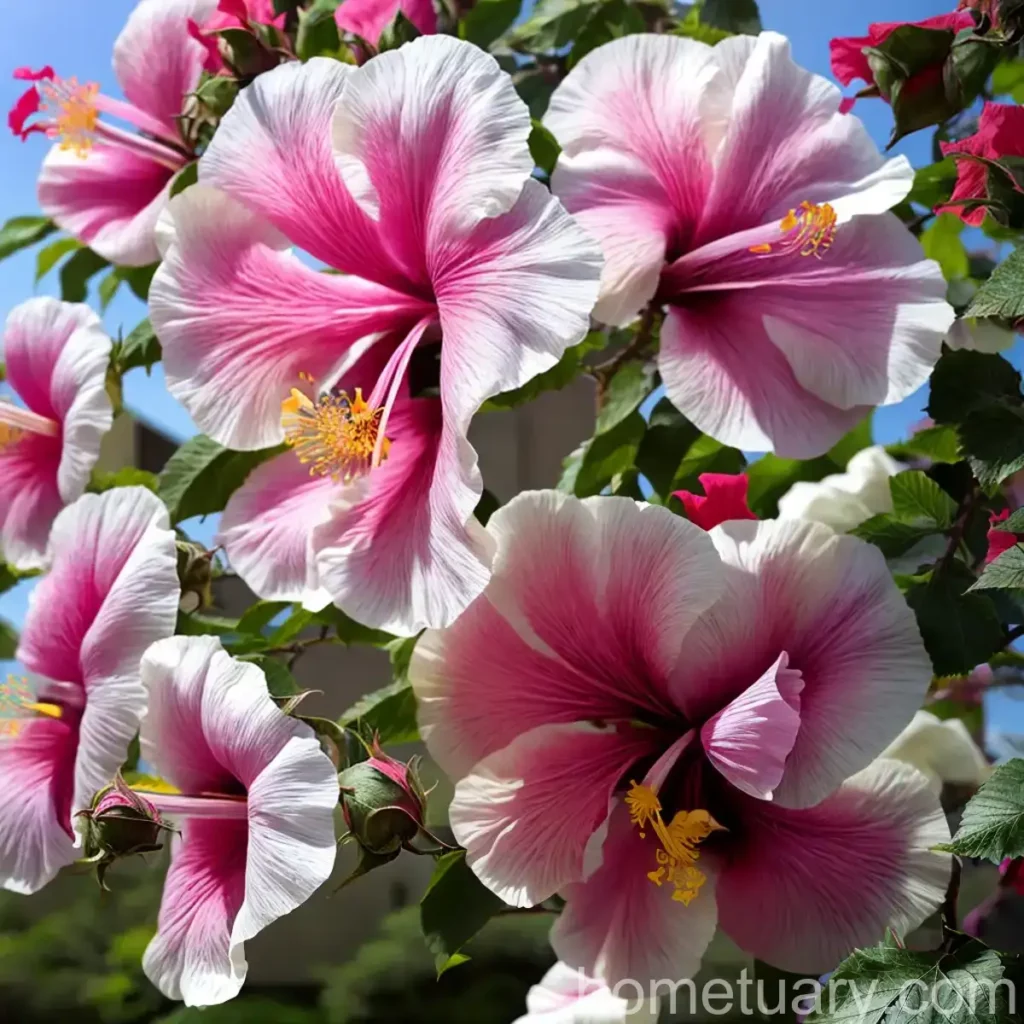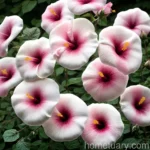The Enchanting Rose of Sharon (Hibiscus syriacus ‘Aphrodite’)
The Rose of Sharon, scientifically known as Hibiscus syriacus ‘Aphrodite’, is an exquisite flowering shrub that captivates admirers with its vibrant blooms. Renowned for its durable nature and charm, this revered plant has been a beloved addition to gardens for centuries. In this comprehensive guide, we will explore the cultural significance, uses, cultivation requirements, potential issues, and remarkable attributes of the Rose of Sharon.
What is Hibiscus syriacus ‘Aphrodite’?
The Hibiscus syriacus ‘Aphrodite,’ commonly known as Rose of Sharon, is a deciduous shrub belonging to the Malvaceae family. It is native to Asia and has been not only a symbol of beauty and love in many cultures but also serves practical purposes in medicine and horticulture.
Key Takeaways
- Rose of Sharon (Hibiscus syriacus ‘Aphrodite’) is a stunning flowering shrub with cultural and medicinal significance.
- Its vibrant blooms and adaptability make it a popular choice in gardens and landscapes.
- Understanding its cultivation, including sunlight, water, soil, and pruning, is essential for its optimal growth and health.
Culture
Uses
The Rose of Sharon serves both ornamental and practical purposes. It is often used as a focal point in landscapes, as a hedge, or as a beautiful addition to mixed borders. In traditional medicine, the plant’s flowers are utilized for various therapeutic purposes, including treating inflammation and fever.
Water
Hibiscus syriacus ‘Aphrodite’ generally prefers moist, well-drained soil. However, it has moderate drought tolerance once established. Regular watering is crucial during dry periods, especially in the initial stages after planting.
Sunlight
For optimal growth and flowering, the Rose of Sharon thrives in full sunlight. It requires at least six hours of direct sunlight per day. Adequate sunlight promotes robust blooming and overall plant vigor.
Fertilizer
A balanced, slow-release fertilizer is recommended for Rose of Sharon during the growing season. Fertilizing in early spring, before new growth emerges, promotes healthy development and profuse flowering.
Soil
This plant thrives in well-draining, slightly acidic to neutral soil. Moreover, it adapts well to various soil types, making it suitable for a wide range of landscapes.
Pruning
Pruning is essential for maintaining the desired shape and size of the plant, as well as encouraging abundant blooms. It is best to prune the Rose of Sharon during late winter or early spring, before new growth begins.
Propagation
The Hibiscus syriacus ‘Aphrodite’ can be propagated via seeds, softwood cuttings, or semi-hardwood cuttings. Softwood cuttings are usually taken in early summer, while semi-hardwood cuttings are more appropriate in late summer to early autumn.
Container Popularity
The Rose of Sharon is well suited for container gardening, allowing individuals with limited space to enjoy its beauty. When planted in containers, ensure that the soil is well-draining, and the plant receives adequate sunlight and water.
Common Diseases
Disease Diagnosis
Common diseases that may affect the Rose of Sharon include:
1. Cercospora Leaf Spot: Identified by small, brown spots with yellow halos on the plant’s leaves.
2. Aphids and Whiteflies: These pests can cause yellowing or curling of leaves and a sticky substance known as honeydew on the plant.
These diseases can be managed through proper cultural practices and, if necessary, by using suitable fungicides and pesticides.
Common Pests
The Rose of Sharon may be susceptible to pests that include:
1. Japanese Beetles: They feed on the foliage and can cause severe damage to the plant.
2. Spider Mites: These pests are tiny and can cause stippling on the leaves, leading to discoloration and reduced plant vigor.
Mitigating pest issues can be achieved through regular monitoring, promoting natural predators, and using appropriate pest control methods when necessary.
Botanist’s Tips
Fun Facts
- The Rose of Sharon is revered in Korean culture, where it is known as “Mugunghwa” and represents the resilience and fortitude of the Korean people.
- The plant’s flowers can be used to make herbal tea, a popular practice in various parts of the world.
Links to External Resources
For additional insights into the fascinating world of the Hibiscus syriacus ‘Aphrodite,’ you can explore the following resources:
– Royal Horticultural Society for expert gardening advice and plant information.
– American Society for Horticultural Science for research articles and horticultural science resources.
In conclusion, the Rose of Sharon (Hibiscus syriacus ‘Aphrodite’) stands as a testament to nature’s beauty and resilience. Its enchanting blooms, cultural significance, and diverse uses make it an invaluable addition to any garden or landscape. By understanding and meeting its specific cultural requirements, enthusiasts can cultivate and appreciate the allure of this magnificent shrub.
As we delve further into the realm of horticulture, the Rose of Sharon remains a timeless symbol of grace and vitality, captivating generations with its enduring charm.
Keywords: Rose of Sharon planting tips, Hibiscus syriacus ‘Aphrodite’ care, How to grow Rose of Sharon, Best conditions for Hibiscus syriacus ‘Aphrodite’, Rose of Sharon pruning guide, Hibiscus syriacus ‘Aphrodite’ propagation methods, Common pests and diseases of Rose of Sharon, Hibiscus syriacus ‘Aphrodite’ water requirements, Rose of Sharon companion planting, Hibiscus syriacus ‘Aphrodite’ sun exposure preferences, Rose of Sharon varieties, Hibiscus syriacus ‘Aphrodite’ fertilizer needs, Benefits of having Rose of Sharon in your garden, Hibiscus syriacus ‘Aphrodite’ blooming season, Rose of Sharon landscape ideas, Hibiscus syriacus ‘Aphrodite’ pruning techniques, Ideal soil conditions for Rose of Sharon, Hibiscus syriacus ‘Aphrodite’ disease-resistant traits, Rose of Sharon container gardening, Hibiscus syriacus ‘Aphrodite’ winter care, Tips for attracting pollinators with Rose of Sharon, Hibiscus syriacus ‘Aphrodite’ scent characteristics, Rose of Sharon varieties for different climates, Hibiscus syriacus ‘Aphrodite’ foliage color, Rose of Sharon in traditional medicine, Hibiscus syriacus ‘Aphrodite’ heat tolerance, Rose of Sharon in landscaping designs, Hibiscus syriacus ‘Aphrodite’ mulching techniques, Drought tolerance of Rose of Sharon, Hibiscus syriacus ‘Aphrodite’ pruning schedule, Rose of Sharon as a privacy hedge, Hibiscus syriacus ‘Aphrodite’ container care, Rose of Sharon and attracting beneficial insects, Hibiscus syriacus ‘Aphrodite’ soil pH preferences, Rose of Sharon flower colors, Hibiscus syriacus ‘Aphrodite’ comparison to other hibiscus varieties, Rose of Sharon planting locations, Hibiscus syriacus ‘Aphrodite’ pests prevention methods, Rose of Sharon medicinal properties, Hibiscus syriacus ‘Aphrodite’ cold hardiness, Rose of Sharon for indoor cultivation, Hibiscus syriacus ‘Aphrodite’ leaf texture, Rose of Sharon as a focal point in the garden, Hibiscus syriacus ‘Aphrodite’ pollination methods, Rose of Sharon in xeriscaping, Hibiscus syriacus ‘Aphrodite’ fall coloration, Rose of Sharon pruning mistakes to avoid, Hibiscus syriacus ‘Aphrodite’ companion plants, Rose of Sharon for attracting hummingbirds, Hibiscus syriacus ‘Aphrodite’ drought-tolerant landscaping.















